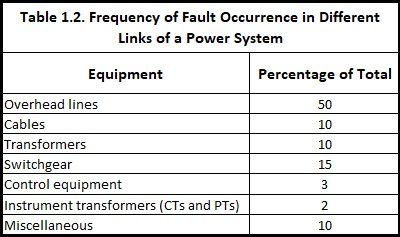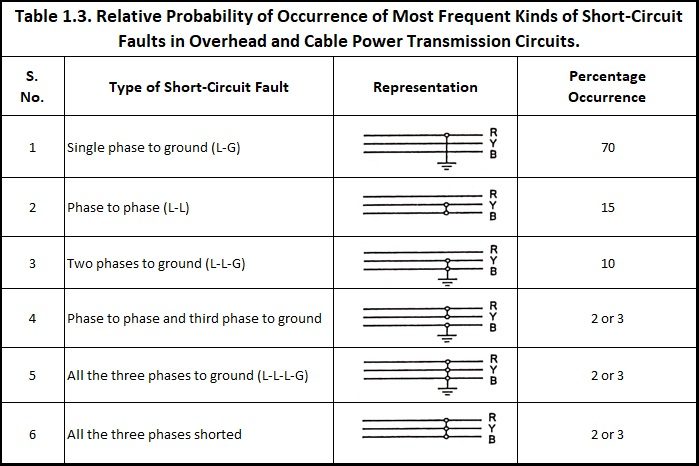Different Types of Faults in Power System:
A fault in an electrical equipment/apparatus is defined as a defect in the electrical circuit due to which current is diverted from the intended path. The nature of a types of faults in power system simply implies any abnormal condition which causes a reduction in the basic insulation strength between phase conductors or between phase conductors and earth or any earthed screen surrounding the conductors. Actually the reduction of insulation strength is not considered as a fault until it creates some effect on the system i.e., until it results either in excessive current or in the reduction of the impedance between conductors or between conductors and earth to a value below that of the lowest load impedance normal to the circuit.
In an electrical power system comprising of generators, switchgear, transformers, power receivers and transmission and distribution circuits, it is inevitable that sooner or later some failure will occur somewhere in the system. The probability of the failure or occurrence of abnormal condition is more on power lines—about one-half of the faults occur on the power lines. This can be explained by the fact that the power lines are widely branched, have greater length, operate under variable weather conditions and are subject to the action of atmospheric disturbances of electrical nature.
According to the causes of incidence, causes of failures may be classified, as mentioned below.
(i) Breakdown may occur at normal voltage due to (a) the deterioration or ageing of insulation and (b) the damages caused by unpredictable happenings such as blowing of heavy winds, tree falling across lines, vehicles colliding with towers or poles, birds shorting out lines, aircraft colliding with lines, line breaks etc.
(ii) Breakdown may occur due to abnormal voltages caused by switching surges or lightning strokes which may be either direct or induced.
The current practice is of providing a high insulation level of the order of 3 to 5 times the nominal value of the voltage but still the insulation strength is reduced because of pollution on an insulator string, commonly caused by deposited soot or cement dust in industrial areas and by windborne sea-spray in coastal areas. Initially the insulation resistance is lowered and small leakage currents are diverted and thus the deterioration is hastened. Even in enclosed installations such as sheathed and armoured cables and metal-clad switchgear, insulation gets deteriorated because of ageing. Void formation in the insulating compound of underground cables due to unequal expansions and contractions caused by the increase and decrease in temperatures is another cause of insulation failure.
The line and apparatus insulation may be subjected to transient overvoltages because of the switching operations. The voltage which rises at a rapid rate may achieve a peak value approaching three times phase-to-neutral voltage. This is the reason that a higher insulation level is provided initially. In case the insulation levels have been correctly chosen and they have not been impaired in a way described under (i) above, the system will withstand these routine overvoltages. But if the insulation gets deteriorated due to one or other reason, it is at the time of switching that failure may occur.
Lightning produces a very high voltage surge in the power system of the order of million of volts and thus it is not feasible to provide insulation which can withstand this abnormality. These surges travel with the velocity of light in the power circuits, the limiting factors are the surge impedance and the line reactance.
The faults can be minimised by improving the system design, quality of the equipment and maintenance. However, the faults cannot be eliminated completely.
Fault Statistics
It is useful to have some ideas of percentages of various causes of faults and frequency of fault occurrence in different links of a power system.
Table 1.1 gives approximately percentagewise the various causes of faults.
Distribution of faults in the various sections of a power system are shown in Table 1.2.
Main Kinds of Fault
The most common and dangerous fault, that occurs in a power system, is the short circuit or shunt fault. They occur as a result of breakdowns in the insulation of current carrying phase conductors relative to earth or in the insulation between phases.
In 3-phase ac power circuits, the short-circuit faults can be classed as follows:
The relative probability of occurrence of various kinds of short circuits in overhead and cable power transmission circuits is given in Table 1.3.
The first four types of faults in power system are of an unsymmetrical nature and give rise to unsymmetrical currents i.e., different currents in the three phases. The latter two types of faults are of symmetrical nature and give rise to symmetrical current i.e., equal fault currents in the three phases with 120° displacement.
The line to ground (L-G) fault occurs most commonly in overhead line practice as indicated in Table 1.3. Fortunately a large number of such faults are transitory in nature and may vanish within a few cycles as would be the case when a twig falls across a line and a cross arm and burns itself out or just falls down. The balanced three-phase fault is very rare in occurrence, accounting for only about 5 per cent of the total, but is the severest of all types of faults in power system and thus imposes the most severe duty on circuit breakers and is used in the determination of the circuit breaker rating. The symmetrical three-phase faults, generally occur due to carelessness of operating personal.



